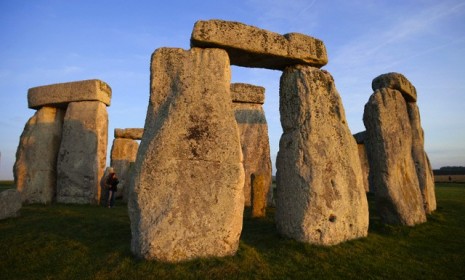A second Stonehenge
Stonehenge once had a wooden twin standing just half a mile away from it. Historians hope it will shed new light on the mysterious monument

Stonehenge, the ancient stone circle in the countryside south of London, once had a wooden twin standing just over half a mile away. That's the theory of a group of British archaeologists anyway, who claim to have found a circular ditch that once contained a ring of wooden structures. (Watch an ITN News report about the discovery.) Here's a quick guide to "Woodhenge":
What exactly was discovered?
Using radar imaging, archaeologists from the University of Birmingham discovered a ring of 24 pits on Salisbury Plain designed to hold wooden posts around 10 feet high.
The Week
Escape your echo chamber. Get the facts behind the news, plus analysis from multiple perspectives.

Sign up for The Week's Free Newsletters
From our morning news briefing to a weekly Good News Newsletter, get the best of The Week delivered directly to your inbox.
From our morning news briefing to a weekly Good News Newsletter, get the best of The Week delivered directly to your inbox.
Is it definitely a companion to Stonehenge?
It seems so. It would have been about the same size as Stonehenge, built on the same orientation and with entrances to the northeast and southwest. Both structures would have been built around the same time — about 4,500 years ago.
What was it for?
As with Stonehenge, no one quite knows. Historians cannot decide whether the original stone circle was built as a sacred site, a burial ground, or simply a means of telling time. Archaeologists now hope this discovery will shed new light on Stonehenge's original purpose.
A free daily email with the biggest news stories of the day – and the best features from TheWeek.com
How significant is the discovery of "Woodhenge"?
It is a "remarkable" finding, says Vince Gaffney of Birmingham University, quoted in CNN. "It will completely change the way we think about the landscape around Stonehenge." Theories that the stone circle existed in "splendid isolation" can now be put to rest. Not only that, says Professor Wolfgang Neubauer, director of the Ludwig Boltzmann Institute in The Guardian, but it is a remarkable breakthrough for imaging technology. "This marks a new departure for archaeologists and how they investigate the past," he says.
Have other ancient structures been found in the area?
Yes. Last year, evidence of another stone circle was discovered on the banks of the River Avon, about a mile away from Stonehenge. Labeled "Bluestonehenge," after the Welsh stone from which it was once built, the circle may have served as a site for cremating the dead before burying them at Stonehenge.
What's next?
The imaging project, known as the Stonehenge Hidden Landscape Project, will map a nine-square-mile area around the stone monument to see what else lies beneath the soil. Given "Woodhenge" was discovered only two weeks into the three-year project, it's likely more interesting material will be found.
Sources: CNN, The Guardian, Christian Science Monitor
-
 Pipe bombs: The end of a conspiracy theory?
Pipe bombs: The end of a conspiracy theory?Feature Despite Bongino and Bondi’s attempt at truth-telling, the MAGAverse is still convinced the Deep State is responsible
-
 The robot revolution
The robot revolutionFeature Advances in tech and AI are producing android machine workers. What will that mean for humans?
-
 Health: Will Kennedy dismantle U.S. immunization policy?
Health: Will Kennedy dismantle U.S. immunization policy?Feature ‘America’s vaccine playbook is being rewritten by people who don’t believe in them’